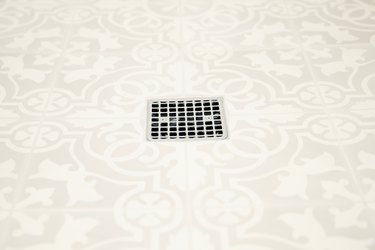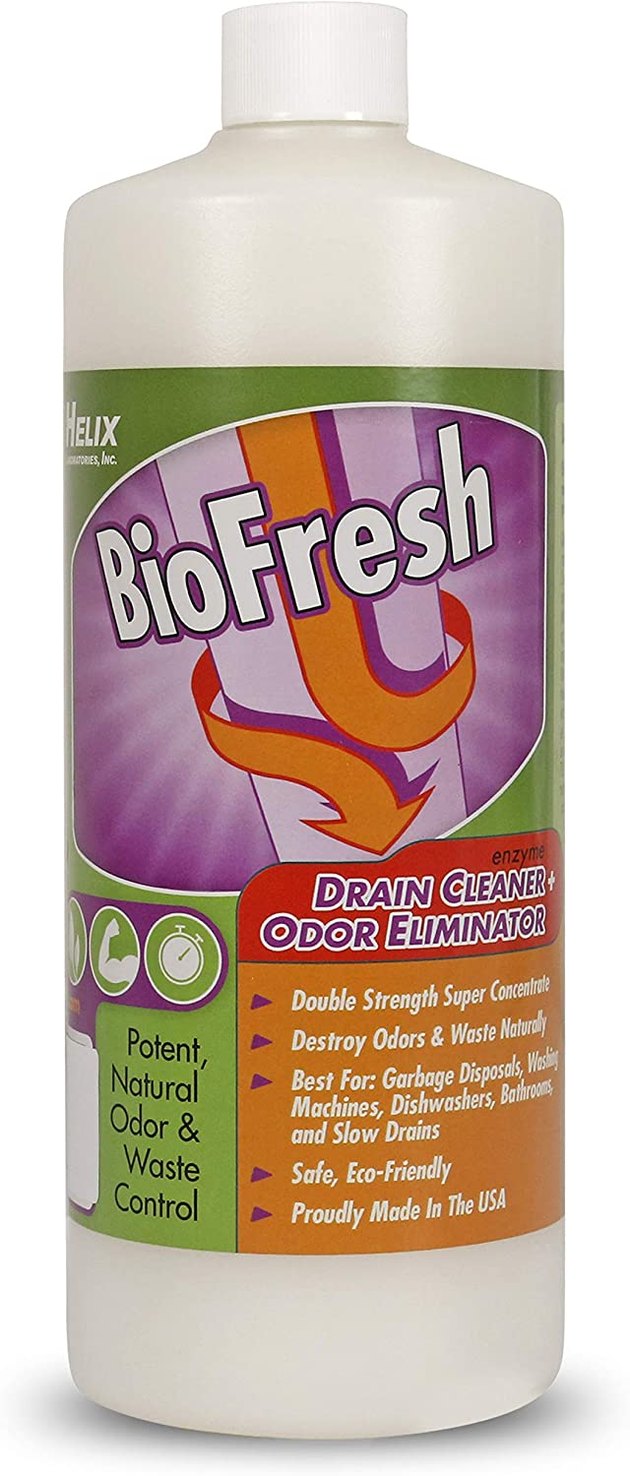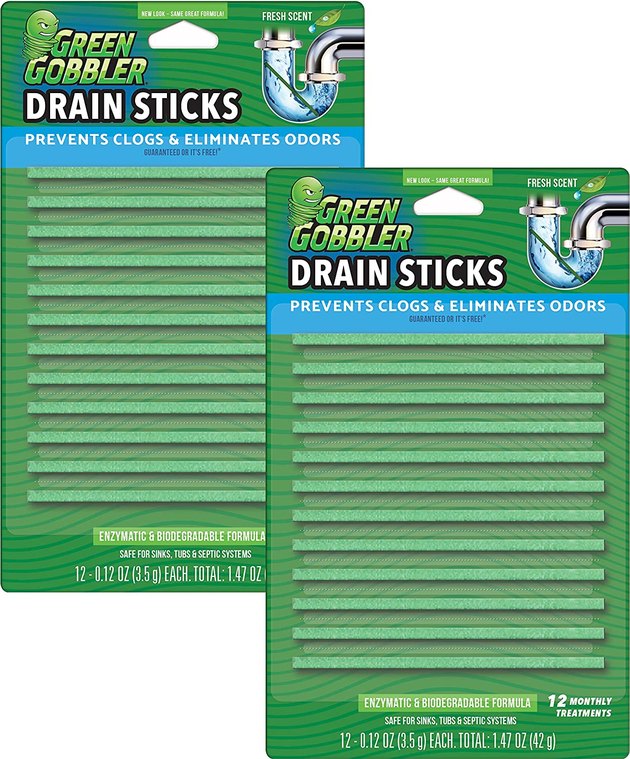In This Article
Showering is supposed to leave you feeling fresh and clean, but that's nearly impossible when you're surrounded by the stench of sewage or rotten eggs. And if bad shower drain smells weren't unpleasant enough already, sometimes they can be a sign of a more serious issue that requires a plumber's attention.
"If you smell a sewer gas smell [in the shower], the culprit could be a broken vent pipe. This is something to get fixed relatively quickly as sewer gas can be bad for you to ingest," says Carly Carey, a plumber for Erik Nelson Plumbing in Minneapolis.
Video of the Day
Video of the Day
But there are less serious (albeit still unpleasant) causes of sewage, musty, or rotten egg smells in the shower drain, Carey says. One cause could simply be a bunch of hair clogging up the drain, or a colony of bacteria or mold that's settled in (yuck).
Read on to learn how to identify the different causes of smelly shower drains, fix the specific problem, and prevent those nasty odors from ever coming back.
How Do I Get Rid of a Smelly Bathroom Drain?
The best way to get rid of a smelly bathroom drain is to first determine the cause. There are four main causes of a smelly shower drain:
- Dry P-Trap
- Dirty drain (due to bacteria, mold, and clogs)
- Blocked roof vent
- Leaky drain
To identify which issue is making your drain smell, we suggest an escalation of troubleshooting, starting with the solution with the least effort: Running water for a dry P-trap, followed by cleaning a dirty drain, then clearing a blocked roof vent, and, finally, fixing a leaky drain, which may require the assistance of a plumber.
Read on to learn more about each cause, and how to solve the issue.
How Do I Get Rid of a Smelly Bathroom Drain?
Dry P-Trap
The P-trap is the U-shaped section of pipe at the bottom of the straight pipe leading down from the shower drain opening. The trap holds a small amount of water that fills the bend of the pipe. This water effectively seals off the pipe from the drainage system and sewer pipe downstream of the shower (this is an integral part of how shower drains work properly).
If you haven't used the shower in awhile, the water in the trap may have dried up so it's no longer sealing out sewer gases, and thus can cause a sewer gas smell in the bathroom.
How to fix a dry P-trap:
- Turn on the shower faucet and let it run for a few minutes. This will fill the trap with water and block the sewer smell.
- If you don't use the shower regularly, you should run the water every few months to prevent a dry trap.
If you are using the shower and the sewer smell persists, it's possible that the P-trap is getting sucked dry due to a venting problem, such as a blocked roof vent. "If simply running water down the drain doesn't fix the smell, you know it's not just a dry P-trap," says Carey.
Clogged Drain
The shower drain is often wet vented, which means the drain pipe doubles as the vent. This means if the drain gets clogged, air can't get in, and the P-trap can empty. Clearing a clog — which can often be identified as the stinky culprit if your shower drain smells like onions — may take a combination of mechanical and chemical methods.
Tip
Though there's not much of a difference between shower drain and tub drain functionality, you do have to take special precautions when clearing clogs from shower drains specifically (which are floor drains). Take care to remove any extraneous objects from a shower drain (like a shampoo cap) before using a plunger to remove a clog.
How to fix a clogged drain and supplies needed:
- Rubber drain stopper (we recommend the Maoyong stopper, $8.99, Amazon)
- Plunger (we recommend the Genuine Joe plunger, $4.25, Amazon)
- Phillips screwdriver
- Drain snake (we commend the Rigid Maxcore drain cleaner cable, $59.99, Amazon)
- Try plunging first. Put a rubber stopper over the drain, turn on the shower, and let the shower pan fill or tub with about an inch of water.
- Remove the stopper, and before the shower has a chance to empty completely, cover the drain with a plunger and pump it about 5-6 times vigorously (you should feel a pretty tight seal here while you're wiggling the plunger up and down). Repeat a few times until you see the water drain easily. If the clog is still present, you'll need to then move onto the drain snake.
- Then try a drain snake. If the smells persist or the drain is still clogged, remove the drain cover with a Phillips screwdriver. Insert the drain snake into the opening of the drain cover, feed the snake in until you feel a bit of resistance (note: a clog will be slight resistance, whereas a turn in the pipe will feel like you're hitting a wall), lock the cable, and twist the tool to undo the clog.
- Then, clear the clog with a drain snake by pulling the cable out. It'll likely be covered with a bunch of gunk, so be prepared with a clean rag to wipe it off and discard.
- Flush the drain with hot water to see if the water drains more easily.
Clogged Drains with Mold
A shower drain is a perfect place for mold to grow because the moisture it needs to thrive is guaranteed. Mold also needs organic matter on which to feed, so the more hair and soap scum there is in the drain, the happier it is and the larger the colony will grow, which increases the intensity of the odor. The good news is that all you have to do is clean and deodorize the drain to get rid of the problem.
How to clean a moldy shower drain and supplies needed:
- Phillips screwdriver
- Rubber gloves (we recommend the SteadMax latex gloves, $7.99, Amazon)
- Safety glasses (we recommend the 3M Safety Glasses, $10.51, Amazon)
- Barbed drain cleaner tool (we recommend the Zip-It drain snake, $14.95, Amazon)
- Drain cleaner and deodorizer (we recommend BioFresh, $24.95, Amazon)
- Flexible drain brush: (we recommend this sewer drain brush, $9.99, Amazon)
- Paint roller cover: (we recommend this Pro Grade paint roller cover, $8.99 for 5, Amazon)
- Remove the drain cover. You may have to remove a screw with a screwdriver to get it off.
- Put on some rubber gloves and safety glasses. Use a barbed drain cleaner tool to pull as much hair as you can out of the drain. This is also an effective way to unclog the shower drain if the water has been draining sluggishly.
- Moisten a rag with some shower drain cleaner and deodorizer and wipe off the rim of the drain. That's the place where mold is most likely to grow.
- Pour some of the drain cleaner into the drain, then pour some on a drain brush and use the brush to scrub the inside surface of the drain pipe as far down as the brush will go. You can also use regular-size paint roller cover for this (most fit snugly inside a 2-inch shower drain pipe). Wet the cover down, then push it in and out the drain several times.
- Turn on the shower faucet to rinse the drain with water.
Clogged Drains with Bacteria
When you do a thorough cleaning with a shower drain deodorizer and cleaner, you'll also kill most of the bacteria responsible for odors that can produce a sewer smell in the bathroom. However, these bacteria tend to live close to the P-trap.
To make sure you get them all, follow the instructions above for removing mold, and push your drain brush in until you feel it contact the bottom of the trap, then scrub thoroughly. After scrubbing and rinsing, it's a good idea to pour some drain cleaner into the drain and let it sit for several hours before using the shower.
Blocked Roof Vent
Suction in the pipes from flowing water can empty the P-trap — therefore causing very smelly drains. But if you've run water through for a few minutes in the shower and it still hasn't fixed it (the easiest fix for a dry P-trap), the problem could be that the vent for the shower drain is blocked. If a blocked roof vent is indeed the cause of your smelly drain, there are more warning signs throughout the house than just the odorous shower smells.
If the vent for the shower is blocked you may notice that:
- the toilet flushes sluggishly
- other drains in the house drain slowly
- you may hear gurgling sounds from the shower and other drains when you flush the toilet
More often than not, the blockage is at the vent opening on the roof, where ice may have collected or an animal may have made a nest.
How to fix a blocked roof vent and supplies needed:
- Extension ladder (we recommend this Werner fiberglass ladder, $399, Lowes.com)
- Garden hose (we recommend this Briggs and Stratton rubber hose, $42.90, Amazon)
- Drain snake (we recommend this Rigid Maxcore drain cleaner cable, $45, Amazon)
- Try clearing obstructions first. Climb on the roof and clear any obstructions you find around the vent pipe opening. (The vent pipe will be about two feet from the roof line, which is where the roof meets the house. If you're uncertain about which vent belongs to your plumbing, it's likely best to call a plumber for this task.)
- Spray water into the vent using a rubber garden hose. Don't use an expandable hose, because it may restrict the water flow. If there's a clog inside the vent, the water pressure may be enough to clear it, but if not, the water will back up.
- Then, try a drain snake. Feed a drain snake into the vent to clear the clog. Insert the drain snake into the opening of the vent, feed the snake in until you feel a bit of resistance, lock the cable, and twist the tool to undo the clog. Then, clear the clog by slowly pulling the cable out. It'll likely be covered with a bunch of debris, so be prepared with a clean rag to wipe it off and discard.
Tip
In the winter, roof vents often get blocked by ice, and it's dangerous to go on a roof that's covered with snow. A safer way to clear the vent is to go in the attic and heat the vent pipe as close to the roofline as possible, using a hair dryer.
Leaking Pipes
A leaking shower drain pipe drips dirty water onto surrounding materials, like flooring, framing, and drywall. The water itself may smell bad, but so can bacteria and mold that thrives in the dampened materials. A large crack in a pipe, however, could let sewer gas enter the home, bringing its own smell. Shower drain pipes are usually difficult to access, so if you suspect this kind of problem, it's best to call a plumber.
A good way to tell it's time to call a plumber is if you've already done several other troubleshooting steps and it's still not helping the smell, says Carey. You'll want to try cleaning the drain, unclogging the drain, running water through the shower, and checking the roof vent for blockages.
"There may be sewer gas exiting the pipes from a break. This can be detected by doing a leak detect — something by looking at the pipes visually — and sometimes using smoke to get a visual of the break," she says.
What is the best cleaner for sewer smell?
If shower drain smells are coming from the sewer, you can't fix the problem with a drain cleaner. However, the hydrogen sulfide waste from bacteria can smell like sewage, and you can do something about that. There are several enzymatic drain cleaners on the market that also deodorize and freshen the drain.
Here are a couple of our favorites:
Can a Plumber Get Rid of the Sewer Smell?
You only need to hire a plumber to get rid of a drain smell if you're sure it's coming from the sewer and you've run the water to make sure the P-trap isn't dry — or you've cleaned the drain thoroughly and the smell doesn't go away. A plumber can check for sewer gas and related problems with the P-trap or the plumbing venting, which can empty out the trap and let sewer gas in.
Maintenance: How to Prevent Shower Drain Smells in the Future
When it comes to shower odors, the main culprit is soap. You can't stop using soap in the shower, but you can prevent it from building up and becoming a problem by pouring hot tap water (not boiling water, which can deform plastic drain pipes) into the drain once a week.
Here are some of our other best tips for maintaining a clean shower drain:
- Remove the drain cover and clean hair out of the drain every six months or as needed (a Zip-It tool like this one on Amazon for $9.99 is perfect for this). Soap collects on hair, so the less hair there is, the less soap buildup there will be.
- Pour an enzymatic drain cleaner into the drain every six months or so and let it sit for six to eight hours before using the shower. This will help control bacteria.
- Use the baking soda foam method to deodorize the drain.
- Pour 1/2 cup of baking soda into the drain
- Follow this with 1/2 cup of white vinegar. The mixture creates a foam that will coat the inside of the drain and help eliminate odors.
- Rinse the drain when the foam subsides.
- Maintain your plumbing. If you notice signs of clogged vents, such as slow-moving drains or gurgling, check the roof vents, and clear any potential clogs as needed. Call a plumber if you suspect blockages in pipes you can't access.


